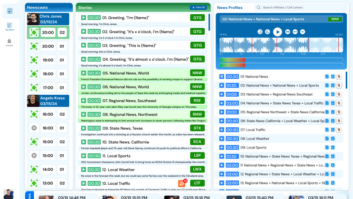Alouette is a French regional radio broadcaster in the western region of the country. Operating 43 frequencies, Alouette now covers 15 local departments (perhaps best described as local administrations). The key to its success is its regional focus and its closeness to its listeners. The broadcaster is known for its wide variety of formats and a prudent use of cutting-edge technology.
One of four studios used to manage Radio Alouette programming.

Based in Herbiers, Vend�e, since 1981, and named after the Mont des Alouette � a peak that has been legendary since the time of the Gauls � Alouette has expanded into a regional network. President Bertrand de Villiers has crafted a local musical style, as well as a team that feels like a family and shares common goals, which include:
? Serving listeners by offering a varied and regionally-oriented radio program.
? Supporting regional events such as sports, culture, fine arts, concerts and shows.
? Expanding areas of coverage in cooperation with our regulatory authority, the CSA (Conseil Sup�rieur de l�Audiovisuel). We do this by securing rights for newly available FM frequencies or by repurchasing bankrupt radio broadcasters if their frequencies are in our coverage area.
? Making wise technological decisions for the present and at the same time keeping an eye out for interesting future developments.
TECHNOLOGICAL OPTIONS
Alouette makes technical decisions internally, after consulting with our technical and human resources teams, and we always meet with manufacturers on our own premises.
In 2017, satellite transmission for Aloutte�s network of stations will undergo a monumental change. We will be switching from one proprietary standard to a new one, DVB-S2, which is designed to be interoperable with all current and future media protocols, whether satellite-based or IP-based.
We had four major goals in mind for the new system:
? Flexibility for transmission sources and coding algorithms.
? Keeping technology as simple and cost-efficient as possible.
? Optimization of quality by use of a well-constructed redundancy concept.
? A solution tailored to the requirements of regional broadcasting.
Since 1996, Alouette has been managing its own multi-channel-per-carrier satellite uplink with its partner in the space segment, Globecast � Eutelsat. That is the main reason why we are not participating in the NSTR project for the change to DVB-S2 standard, which is a merger of several French broadcasters using a common satellite uplink.
The technical team responsible for the DVB-S2 project (from left to right): Frederic Bourgeais (technical director), Stephane Ayreault (IT manager), Vitor Nunes (network and studio engineer) and Yvon Daviaud (low and high fr�quency engineer).

Although we didn�t need access to the NSTR satellite uplink, Alouette engineers were curious why the NSTR project team had chosen a system solution from 2wcom and also interested in their experiences with this system. The positive feedback from the NSTR team in combination with a visit from 2wcom CEO Werner Drews in the summer of 2016 (plus a competitive bid)�were the main reasons why the Alouette DVB-S2 project team chose to work with the German company.
From the beginning, cooperation between both companies� sales teams and engineers has been based on respect and trust, which resulted in a very productive collaboration. We quickly understood that their products are keeping pace with our needs as a broadcaster with a strong regional orientation.
As a further stroke of good luck, 2wcom was also designing its own eight-channel audio MPEG encoder, the MM08E. The main differences between this encoder and the devices of alternative manufacturers that we reviewed were cost-efficiency and configuration simplicity.
To ensure a trouble-free switchover to the DVB-S2 standard we started a test phase in February 2017, obtaining one of each device that were planned for our new system, and I and my technical team took a very close look at all of the functions and interoperability with our system on-site. This was particularly important with regard to the broadcasting of local content.
A PERFECT FIT
We got the very first MM08E at our station and have been in lively dialogue with 2wcom engineers regarding our testing results. Its MPEG encoder can be used in IP and SAT system environments with a great deal of flexibility. The product also offers a wide selection of codecs (Enhanced apt-X, AAC, MPEG I/II Layer 2/3, PCM), as well as RDS data. It generates multiple streams independently.
Satellite distribution equipment shown in Alouette�s rackroom: uplink encoders and confidence receivers.

Transmission of ancillary data and switching contact information (GPIO) can be forwarded via integrated interfaces. In case we need more hardware channels, activation can be managed via software updates. The MM08E offers well-constructed redundancy, including two hot-swappable slide-in power supplies, ensuring operation without interruption.
After several weeks working intensively with the device, we have been impressed by its dependability. Our technical staff have concluded that it is a very complete and competitively priced product rounded out by offering functions for quality management (MPEG FEC and DualStreaming to avoid IP packet loss), controlling (HTTP, Telnet, NMS and SNMP) and monitoring (IP and MPEG parameters via SNMP v2c and relay,� headphone output and alarm, source switch and event logging).
Combined with the eSIRC (Satellite Inband Remote Control) Server and its DSR02+ satellite receivers, this homogeneous global solution enables us to distribute and broadcast local programs and fully control the entire channel with a satellite IP solution. With 2wcom eSIRC, we chose web-based software for remote control that meets our needs for comfort, cost reduction and economical use of available time.
Equipping FlexDSR02+ with SIRC option and an SD card makes it possible to use the whole range of enhanced functions of eSIRC. As a result, our technicians are able to completely access eSIRC management system via web interface from any computer within the network to upload data files to the internal memory of integrated FlexDSR02+ receivers (such as firmware, audio, reports and configuration).
All content stored on internal memory of remote devices is mirrored within the eSIRC, and so our network operators can track the state of internal memory on all integrated devices without the need for a physical connection. If a certain file is scheduled to be uploaded, it will also be stored in the local mirror of the concerned device. As storage space of each device is accessible via web interface and also via FTP, we are able to upload files directly to the system via FTP for distribution via satellite. In case a greater volume of data has to be processed and there is no satellite capacity for it, we have can synchronize content stored on the internal memory cards with the eSIRC mirror by FTP.
Currently, we have 38 industrial computers at each of the sites to manage local news. They receive daily content and programming specific for every city, and are connected by an ADSL line to our master server situated in the head office. Our self-developed software enables every computer to be started in sequence by one or several contact relays coming from our current satellite receiver and encoding audio signals in different formats like MPEG II Layer I to MP3 and AAC. This technology is reliable, but requires regular maintenance.
Because Alouette covers a large area in western France, we did not wish to use only a terrestrial IP technology but also wanted to guarantee availability by using satellite. Some towns in our coverage area simply do not have enough ADSL quality. After evaluating a range of possible products we choose 2wcom�s FlexDSR02+ satellite receivers to handle transport streams via satellite (DVB-S/S2), ASI input and IP, while also managing elementary audio streams and Icecast streams via IP.
This device is able to process all common coding algorithms, like Eapt-X, AAC, MPEG I/II Layer 2/3 or PCM, it�s perfect for our goal of flexibility. Regarding our quality requirements, this multipurpose device offers a sophisticated concept for audio quality and redundancy options such as Pro-MPEG FEC and DualStreaming to avoid IP packet losses. It also includes an effective link redundancy between the satellite and terrestrial IP by providing advanced functions making it possible to pass over automatically from a satellite reception in one flow to a global TS-IP.
During the concept and testing phase, we also had the chance to check the quality of 2wcom�s customer service. It was key that the people involved could work quickly and efficiently together to interface our Zenon Media computerized broadcast systems with 2wcom�s broadcast solutions. For the final switchover to DVB-S2, at least three of the MM08 encoders will be deployed in the technical room, as well as one eSIRC Server and 38 DSR02+ satellite receivers.
This major switchover involves 43 pieces of receiving equipment has already started and will be finished by September. Our internal structure will ultimately enable us to multiplex three programs at once, for a start. Alouette manages 16 frequencies of its own; the other 27 are divided between Towercast and TDF.
MORE ON THE FM SYSTEM
Alouette�s engineering lab where devices are tested and evaluated.

Among their 43 transmitters, Alouette has at least one of historical significance, located at Mont des Alouettes, with an authorized power of 10 kW ERP � one of only a few commercial stations authorized at that level of power in France. This particular site uses a 12-bay Kathrein antenna type 754 154 with circular polarization, at a height of 86 meters above ground.
Alouette�s other sites are at power levels between 100 and 2,000 Watts ERP. About 95 percent of Alouette�s transmitters are made in France by Ecreso, with the balance manufactured by GatesAir (type ZX).
At most of sites Alouette uses two-bay omnidirectional antennas made by ITAS. Along the west coast, the company uses other panel-mounted dipoles, by Kathrein for additional directionality.
Back at the studio headquarters, the company uses much that U.S. broadcasters would find familiar � Audio Arts D75 consoles and Pro Tools editing systems.
What makes Alouette special is that it has retained its powerful sense of family and team spirit, supported by a chief executive who emphasizes wise technological choices. This human element helps to ensure that Alouette will remain among the most vital broadcasters in France.
Alouette thanks Werner Drews, Nicole Petersen, Anke Schneider, S�nke Schmidt, Ralph Magnussen, Kai Gerkens, Stephan Preuss and Tork Niendorf.
Bourgeais is technical director for Alouette.












